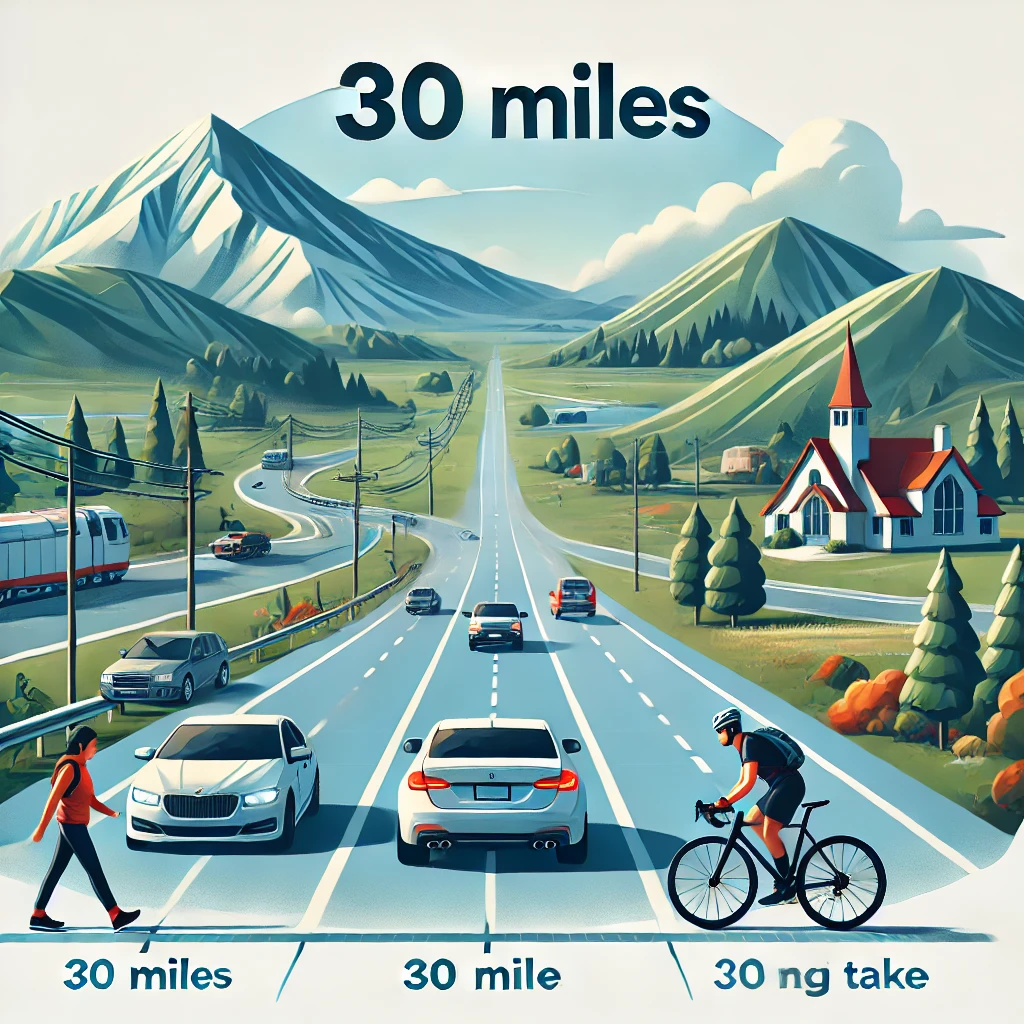When people hear «30 miles,» it might not sound like much or could seem like an overwhelming distance, depending on context. But understanding how long it feels or takes to travel that distance depends heavily on factors like speed, mode of transportation, and terrain. Whether you’re a traveler, commuter, or distance learner, let’s break down the answer to «how long is 30 miles?» and what it means in different scenarios.
Walking 30 Miles
Walking is the simplest way to visualize 30 miles. The average walking speed is about 3 miles per hour (mph), though this can vary depending on fitness level, terrain, and breaks taken along the way.
- Time Estimate: At 3 mph, walking 30 miles would take about 10 hours without breaks. For most people, that’s a full day’s activity.
- Context: Long-distance hikers or marathon walkers might cover such a distance in a day, but for casual walkers, 30 miles is an ambitious goal.
Considerations for Walking:
- Terrain affects how long it takes to walk 30 miles. Uphill trails slow you down, while flat roads allow you to maintain a steady pace.
- Fitness Level matters. Regular walkers or hikers might complete this distance more efficiently, whereas beginners may need rest breaks.
Running 30 Miles
For runners, 30 miles represents a significant distance. It’s just under the length of an ultramarathon and more than double a half-marathon (13.1 miles).
- Time Estimate: A person running at an average speed of 6 mph (a 10-minute mile pace) can complete 30 miles in about 5 hours. Elite runners going faster could finish in considerably less time.
- Context: Endurance runners often train for distances like this when preparing for marathons or ultramarathons.
Tips for Understanding 30 Miles as a Run:
- Pace Variation greatly affects timing. Faster runners might complete 30 miles in under 4 hours, while some may take 6 or more hours.
- Runners should also factor in hydration, nutrition, and recovery, crucial for long distances.
Driving 30 Miles
Driving 30 miles is noticeably faster compared to walking or running, but the exact time depends on traffic and speed limits.
- Time Estimate:
-
- At 30 mph (city driving), 30 miles would take 1 hour.
- At 60 mph (highway speed), 30 miles takes just 30 minutes.
-
- Context: Short commutes, road trips, or city drives often span similar distances.
Things to Keep in Mind:
- Heavy traffic congestion or frequent stops (red lights, intersections) can easily double or triple travel time.
- Rural routes or highways typically allow for faster travel.
Cycling 30 Miles
Cycling is a popular activity among fitness enthusiasts, and 30 miles is a moderate challenge for an intermediate biker. Speed and terrain influence how long this distance could take.
- Time Estimate:
-
- A casual cyclist maintaining around 10-12 mph may finish 30 miles in about 2.5 to 3 hours.
- Experienced cyclists or those using road bikes can go faster, completing the trip in less than 2 hours.
-
Factors for Cyclists:
- Wind resistance and elevation play huge roles. Uphill rides are slower, while downhill or flat rides are quicker.
- Gear and fitness also impact speed. High-quality bikes with proper gear-shifting mechanisms can significantly shorten ride times.
Flying 30 Miles
For perspective, flying 30 miles in an airplane happens in the blink of an eye. At cruising speeds of over 500 mph, planes cover 30 miles in less than 4 minutes! However, flights over such short distances are rare since takeoff and landing account for the bulk of time.
- Time Estimate: Depending on the type of aircraft, 30 miles could take as little as 3-5 minutes during steady flight.
Alternative Air Travel:
- Short-distance trips via helicopters or drones are becoming more common, especially in deliveries or transportation innovations.
Contexts Where 30 Miles Matters
1. Daily Commutes
For commuters, 30 miles is a common distance between suburban homes and city workplaces. Driving, biking, or using public transportation can make this distance manageable within 30 minutes to 1 hour, depending on traffic and transportation speed.
2. Travel Planning
Travelers often calculate distances to estimate how long it’ll take between destinations. Knowing how long it takes to cover 30 miles by car, foot, or public transport can make planning routes easier.
3. Fitness Goals
For distance learners, athletes, or those participating in endurance events, 30 miles can signify various benchmarks—from marathon training to long cycling goals.
Frequently Asked Questions (FAQs)
Q: How many steps does it take to walk 30 miles?
The average person takes about 2,000 steps per mile, so walking 30 miles would require approximately 60,000 steps.
Q: Can you walk 30 miles in one day?
It’s possible but depends on your fitness level and the time available. If it takes 10 hours of walking with no breaks, add time for rest and food to realistically complete the distance in 12-14 hours.
Q: What’s a comparable landmark for 30 miles?
30 miles is roughly the distance between downtown Los Angeles and Disneyland or the distance one might cover in a long-distance cycling event.
Q: Is running 30 miles bad for you?
For trained endurance athletes, running 30 miles as part of preparation for ultramarathons is not unusual. However, for those untrained for long runs, such a distance could lead to exhaustion or injury. Proper training is key.
Same Distance, Different Experiences
Whether you’re calculating travel time for a long drive, gauging fitness challenges for running or cycling, or even contemplating walking, “how long is 30 miles” is a question with endless context-based answers.
How you approach 30 miles depends on your mode of transport, speed, and surrounding conditions. Interested in covering similar distances on foot or wheels? Start preparing now and build the endurance to tackle 30 miles comfortably.








